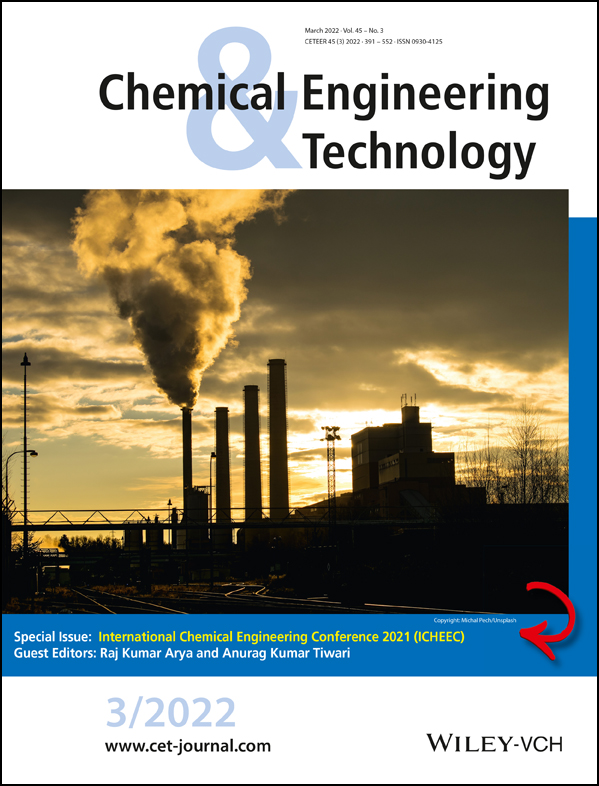Comparative Study of Two Identical Industrial Digesters Using Radiotracer-Based Residence Time Distribution Measurement
Meenakshi Sheoran
Thapar Institute of Engineering and Technology, Department of Chemical Engineering, 147004 Patiala, Punjab, India
Search for more papers by this authorCorresponding Author
Avinash Chandra
Thapar Institute of Engineering and Technology, Department of Chemical Engineering, 147004 Patiala, Punjab, India
Correspondence: Avinash Chandra ([email protected]), Department of Chemical Engineering, Thapar Institute of Engineering and Technology, Patiala, Punjab, 147004, India.Search for more papers by this authorArvind Kumar Gautam
National Institute of Technology Hamirpur, Department of Chemical Engineering, 177005 Himachal Pradesh, India
Search for more papers by this authorRaj Kumar Arya
Dr. B. R. Ambedkar National Institute of Technology, Department of Chemical Engineering, 144011 Jalandhar, Punjab, India
Search for more papers by this authorHaripada Bhunia
Thapar Institute of Engineering and Technology, Department of Chemical Engineering, 147004 Patiala, Punjab, India
Search for more papers by this authorHarish J. Pant
Bhabha Atomic Research Centre, Isotope Production and Applications Division, 400085 Mumbai, India
Search for more papers by this authorMeenakshi Sheoran
Thapar Institute of Engineering and Technology, Department of Chemical Engineering, 147004 Patiala, Punjab, India
Search for more papers by this authorCorresponding Author
Avinash Chandra
Thapar Institute of Engineering and Technology, Department of Chemical Engineering, 147004 Patiala, Punjab, India
Correspondence: Avinash Chandra ([email protected]), Department of Chemical Engineering, Thapar Institute of Engineering and Technology, Patiala, Punjab, 147004, India.Search for more papers by this authorArvind Kumar Gautam
National Institute of Technology Hamirpur, Department of Chemical Engineering, 177005 Himachal Pradesh, India
Search for more papers by this authorRaj Kumar Arya
Dr. B. R. Ambedkar National Institute of Technology, Department of Chemical Engineering, 144011 Jalandhar, Punjab, India
Search for more papers by this authorHaripada Bhunia
Thapar Institute of Engineering and Technology, Department of Chemical Engineering, 147004 Patiala, Punjab, India
Search for more papers by this authorHarish J. Pant
Bhabha Atomic Research Centre, Isotope Production and Applications Division, 400085 Mumbai, India
Search for more papers by this authorAbstract
Radiotracer-based residence time distribution (RTD) measurements were performed for two identical wheat straw pulping digesters to evaluate and compare their performances. The radiotracer technetium (99mTc) as sodium pertechnetate was used to follow the liquid phase inside the digester. The product quality of both digesters was not identical for similar sets of operating conditions. Temperature, pressure, and mass flow rates were the influencing parameters, and the experimental and theoretical mean residence time (MRT) were compared. A significant amount of flow abnormalities was observed in the second digester as compared to the first one, including channeling, dead volume, scaling, and bypassing. The axial dispersion model and tank in series with the back-mixing model were suitable for modeling the obtained RTD data.
References
- 1 H. B. Abdelouahed, N. Reguigui, N. E. Abbes, Appl. Radiat. Isot. 2016, 115, 1–3. DOI: https://doi.org/10.1016/j.apradiso.2016.05.027
- 2
P. Bajpai, Bleach Plant Effluents from the Pulp and Paper Industry, Springer, Heidelberg
2013.
10.1007/978-3-319-00545-4 Google Scholar
- 3 M. Sheoran, A. Chandra, H. Bhunia, P. K. Bajpai, H. J. Pant, Chem. Eng. Commun. 2018, 206, 739–758. DOI: https://doi.org/10.1080/00986445.2017.1410478
- 4 N. Othman, S. K. Kamarudin, Sci. World J. 2014, 768604, 1–14. DOI: https://doi.org/10.1155/2014/768604
- 5 M. Sheoran, S. Goswami, H. J. Pant, J. Biswal, V. K. Sharma, A. Chandra, H. Bhunia, P. K. Bajpai, S. M. Rao, A. Das, Appl. Radiat. Isot. 2016, 111, 10–14. DOI: https://doi.org/10.1016/j.apradiso.2016.01.025
- 6 D. C. Guio-Perez, T. Proll, H. Hofbauer, Chem. Eng. Res. Des. 2013, 92, 1107–1118. DOI: https://doi.org/10.1016/j.cherd.2013.10.018
- 7 W. Iqbal, G. U. Din, S. Mehdi, I. R. Chughtai, H. M. Inayat, I. H. Khan, NFC IEFR J. Eng. Sci. Res. 2017, 1, 104–109. DOI: https://nijesr.com/ojs/index.php/archive/article/view/75
- 8 M. Jafarikojour, M. S. Sayed, J. R. M. Rezaei, Chem. Eng. Res. Des. 2016, 109, 86–96. DOI: https://doi.org/10.1016/j.cherd.2016.01.003
- 9 H. G. Koennecke, D. Luther, K. Koepping, J. Schoen, H. Ulrich, Acta Hydrochim. Hydrobiol. 1984, 12, 431–434. DOI: https://doi.org/10.1002/aheh.19840120416
- 10 R. Kumar, H. J. Pant, S. Goswami, V. K. Sharma, A. Dash, S. Mishra, K. Bhanja, S. Mohan, S. M. Mahajani, Appl. Radiat. Isot. 2017, 121, 51–60. DOI: https://doi.org/10.1016/j.apradiso.2016.12.007
- 11
O. Levenspiel, Chemical Reaction Engineering, 3rd ed., Wiley, New York
1999.
10.1021/ie990488g Google Scholar
- 12 H. J. Pant, A. Kundu, K. D. P. Nigam, Rev. Chem. Eng. 2001, 17, 165–252. DOI: https://doi.org/10.1515/REVCE.2001.17.3.165
- 13 H. J. Pant, V. N. Yelgoankar, Appl. Radiat. Isot. 2002, 57, 319–325. DOI: https://doi.org/10.1016/S0969–8043(02)00093-3
- 14 H. J. Pant, V. K. Sharma, A. G. C. Nair, B. S. Tomar, T. N. Nathaniel, A. V. R. Reddy, G. Singh, Appl. Radiat. Isot. 2009, 67, 1591–1599. DOI: https://doi.org/10.1016/j.apradiso.2009.03.115
- 15 H. J. Pant, V. K. Sharma, G. Singh, V. K. Raman, J. Bornare, R. R. Sonde. J. Radioanal. Nucl. Chem. 2012, 294, 59–63. DOI: https://doi.org/10.1007/s10967-011-1511-2
- 16 O. Potier, J. P. Leclerc, M. N. Pons, Water Res. 2005, 39, 4454–4462. DOI: https://doi.org/10.1016/j.watres.2005.08.024
- 17 S. Goswami, H. J. Pant, M. Sheoran, A. Chandra, V. K. Sharma, H. Bhunia, J. Radioanal. Nucl. Chem. 2020, 323, 1373–1379. DOI: https://doi.org/10.1007/s10967-019-06730-3
- 18
M. Sheoran, A. Chandra, S. Ahuja, H. Bhunia, H. J. Pant, Int. J. Chem. React. Eng.
2019, 17, 20180192 (1–13). DOI: https://doi.org/10.1515/ijcre-2018-0192
10.1515/ijcre?2018?0192 Google Scholar
- 19 M. Sheoran, A. Chandra, H. Bhunia, P. K. Bajpai, H. J. Pant, S. M. Rao, IPPTA: Quart. J. Indian Pulp Pap. Tech. Assoc. 2016, 28, 33–40. https://secureservercdn.net/160.153.137.99/i8r.38d.myftpupload.com/wp–content/uploads/2021/01/2016_Issue_3_IPPTA_Article_01.pdf)
- 20
M. Sheoran, A. Chandra, H. Bhunia, P. K. Bajpai, H. J. Pant, Iran. J. Chem. Chem. Eng.
2021, 40, 313–321. DOI: https://doi.org/10.30492/IJCCE.2020.39047
10.30492/IJCCE.2020.39047 Google Scholar
- 21 M. Sheoran, N. Kaur, A. Chandra, A. K. Gautam, R. K. Arya, J. Indian Chem. Soc. 2020, 97, 403–408. (http://indianchemicalsociety.com/portal/uploads/journal/2020_03_20_Extended_1591134554.pdf)
- 22
H. Sixta, Handbook of Pulp, Vol. 1, Wiley-VCH Verlag GmbH & Co. KGaA, Weinheim
2006.
10.1002/9783527619887 Google Scholar




